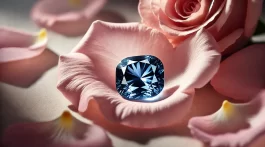Discover the Secret History of Birthstones
| For centuries, or perhaps longer, birthstones representing our month of birth have captivated humanity. From mystical power to subtle symbolism, our birthstone is a symbol that communicates who we are. Have you ever wondered how the Western birthstone tradition began? Let’s peel back the layers of history, lore, and more as we peer into the fascinating history of birthstones, discovering their secrets and learning their meaning. Would it surprise you learning our modern birthstone tradition has Biblical origins?
And thou shalt set in it settings of stones, even four rows of stones: the first row shall be a sardius, a topaz, and a carbuncle: this shall be the first row.
And the second row shall be an emerald, a sapphire, and a diamond.
And the third row a ligure, an agate, and an amethyst.
And the fourth row a beryl, and an onyx, and a jasper: they shall be set in gold in their inclosings.
-Exodus 28:17-20, King James Version (KJV)
What is the High Priest’s Breastplate?

Watercolor of Aaron donning the vestments of the High Priest.
By Biblical accounts, the High Priest’s Breastplate was created for Aaron, the first High Priest of Israel, appointed by God. The High Priest’s Breastplate is a symbol of rank. Worn by the High Priest of the Israelites, they served as the unifying figure of Judaism until the destruction of their original temple in the first century.
Different lists are given and debated by scholars, but everyone agrees that the Breastplate contains twelve different gemstones. These gemstones each feature an inscription symbolizing one of the twelve tribes of Israel. Accounts of what the actual stones is debatable due to translators favoring different interpretations of the text. Some of the stones suggested by conflicting sources may not have been available in the Ancient World. Or some, like the diamond, would not have been workable with the tools and methods available. Therefore, carving them wouldn’t be possible.
A Jewish historian, Flavian Josephus, initially proposed a connection between these jewels, the months of the year, and the tropical zodiac. Later, St. Jerome, an early and prominent figure of the Christian church, proposed that these symbolic stones could be used by Christians too. His writings have let scholars trace the use of birthstones to at least as early as the fourth century.
Western Birthstone Traditions: Ancient and Modern
Many cultures express different birthstone traditions. In Europe, the early history of birthstones shows that the popular custom associated with the Breastplate was to wear a stone that corresponds with the current month of the year. This remained the case for many centuries, mostly confined to the elite who could afford precious gemstones.
Experts disagree on when people began wearing stones only for their birth month, but the custom is only a few centuries old. The Gemological Institute of America suggests that birthstones, as we know them, were first worn during the 14th and 15th centuries. In “The Curious Lore of Precious Stones,” Kunz suggests that the custom is more modern, only starting in the 19th century.
No matter when it began, it’s been a popular style since! By the early 20th century, the modern birthstone list came into being. These special stones were selected by the Jewelers of America, representing our greater knowledge of gemstones since the early days of gemology. Since then, the list undergoes periodic updates. Spinel, joining in 2016, is the most recent addition. Find your birthstone below, and follow the link to learn more.
- January Birthstone: Garnet
- February Birthstone: Amethyst
- March Birthstone: Aquamarine
- April Birthstone: Diamond
- May Birthstone: Emerald
- June Birthstone: Pearl, Moonstone, and Alexandrite
- July Birthstone: Ruby
- August Birthstone: Peridot and Spinel
- September Birthstone: Sapphire
- October Birthstone: Opal and Tourmaline
- November Birthstone: Citrine and Topaz
- December Birthstone: Tanzanite, Turquoise, and Zircon





[…] his writings, Kunz tells us that garnet is the Aquarius birthstone. Even before the modern birthstone list, many cultures identified amethyst as a birthstone associated with this time of year. Garnet has […]
[…] Many believe that birthstones bestow luck. Furthermore, they are an excellent gift for lovers of jewelry and souvenirs. Whether you prefer classic or modern methods, birthstones are a unique way to tell your story. To learn more about each month’s birthstone, check out our handy birthstone guide! […]
[…] born, emerald is their birthstone. It is believed that the origin of birthstones dates back to the Breastplate of Aaron, which had twelve gemstones representing of the twelve tribes of […]
[…] his writings, Kunz tells us that amethyst is the Pisces birthstone. Even before the modern birthstone list, many cultures identified amethyst as a birthstone associated with this time of year. Amethyst has […]
[…] jewelry is another attractive choice for those in love, as it’s both beautiful and meaningful. Each birthstone has special meaning that adds a lovely sentiment to jewelry. For example, May’s birthstone, the emerald, is […]
[…] This red stone has its roots in ancient times. There are records of garnet being used as birthstones as early as the 15th century. Ancient Egyptian, Greek, and Roman cultures widely used the gem for various purposes. Ancient Romans used garnet signet rings to stamp documents. Legends say that garnet lit Noah’s Ark and was one of the jewels in the Breastplate of Aaron. […]
[…] birthstones lore traces its roots back to Aaron’s breastplate, they are a relatively modern concept. There are records of garnets being used as birthstones as […]
[…] you know the religious roots of birthstones? Perfect for the traditional type, a birthstone cross connects the symbolism of both into one […]